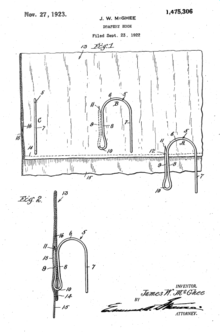Drapery hook
The drapery hook is a hook designed for hanging drapery. The distinctive shape shown in the figure, with a sharp end and a blunt end, was patented by James William McGhee (1882–1968) in the 1920s. Numerous other drapery hooks were patented before and after this common design.

Patents
Infringement
Patent 1475306 was the subject of an infringement lawsuit that McGhee lost and appealed. He lost again on appeal when the United States Court of Appeals for the Ninth Circuit found that hook designs were not patentable in 1929:
With the lower court, we fail to find in plaintiffs' device any patentable novelty; certainly there is no invention in the hook member. Hooks of all shapes and materials are among the commonest things of life. In size, strength, and shape they are to be adapted to needs and tastes, and the adaptation of a hook to suit the pole, rod, bar, or rings from which the drapery is to hang is readily made by any person of common intelligence. There is no invention.[1] [2]
References
- "McGhee & Jinks v. Le Sage & Co., Inc". United States Court of Appeals for the Ninth Circuit. May 27, 1929. Retrieved 2008-03-02.
Suit by James W. McGhee and another, trading as McGhee & Jinks, against Le Sage & Co., Inc. From a decree of dismissal, plaintiffs appeal. Affirmed. ... With the lower court, we fail to find in plaintiffs' device any patentable novelty; certainly there is no invention in the hook member. Hooks of all shapes and materials are among the commonest things of life. In size, strength, and shape they are to be adapted to needs and tastes, and the adaptation of a hook to suit the pole, rod, bar, or rings from which the drapery is to hang is readily made by any person of common intelligence. There is no invention.
- "Decisions of the Commissioner of Patents and of the United States Courts". United States Patent Office. 1929. Retrieved 2008-03-02.
Suit by James W. McGhee and another, trading as McGhee & Jinks, ... The spring pressure between the pointed arm and the hook tends to hold the device to ...